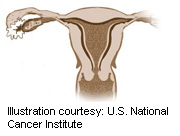
SATURDAY, July 12, 2014 (HealthDay News) — There’s no way to guarantee that a surgical technique used to grind up uterine growths and remove them through tiny incisions won’t increase the risk of spreading cancer to other parts of a woman’s body, U.S. health advisers said Friday.
The advisory panel to the Food and Drug Administration also said that women who do undergo the procedure — called laparoscopic power morcellation — should sign a written consent stating that they understand the potential risks, the Associated Press reported.
The panel’s advisory opinion follows an April 17 warning from the FDA that the procedure can inadvertently spread cancerous tissue beyond a woman’s uterus and into other parts of her body.
The FDA hasn’t set a decision date on the use of power morcellator devices, the AP said. The agency isn’t obliged to follow the advice or recommendations of its advisory committees but usually does so.
Surgeons frequently use laparoscopic power morcellation when they perform a hysterectomy or remove uterine fibroids, which are noncancerous growths on the smooth muscle tissue on the wall of the uterus.
The minimally invasive procedure uses a power tool to chop up the tissue of the fibroids or, in the case of a hysterectomy, the uterus itself. These tissue fragments are then removed through tiny incisions, according to background information from the FDA.
The agency estimates that about one in 350 women undergoing a hysterectomy or fibroid removal has an unsuspected type of cancer called uterine sarcoma.
If a surgeon performs power morcellation on these women, there’s a risk the procedure will spread the cancerous tissue within the patient’s abdomen and pelvis.
About 60,000 of these procedures are performed every year, estimated Dr. William Maisel, deputy director for science and chief scientist at the FDA’s Center for Devices and Radiological Health.
The FDA stopped short in April of banning the power morcellation devices from the market, but is urging physicians and patients to weigh the risks prior to their use.
“Women should ask their health care provider if power morcellation will be used during the procedure, and explain why it’s the best option,” Maisel said at an April 17 news conference.
Women who already have undergone power morcellation don’t need to get a cancer screening, because some of the tissue removed during the procedure would have been sent for pathologic analysis, Maisel said. If cancer had been detected, they would have been informed, he added.
“We think that most women who have undergone these procedures require routine care,” he said. “If they don’t have any ongoing or recurrent symptoms, they should be fine.”
Most women will develop uterine fibroids at some point in their lives, according to the U.S. National Institutes of Health. These fibroids can cause symptoms such as heavy or prolonged menstrual bleeding, pelvic pain or frequent urination.
Women who need a hysterectomy or fibroid removal can still undergo traditional or laparoscopic surgery, just without the use of a power morcellator, Maisel said.
The agency has instructed manufacturers of power morcellators to review their current product labeling for accurate risk information for patients and health care professionals.
The FDA approved the first power morcellator for use in 1995, Maisel said. A non-power version of the morcellator received FDA approval in 1991.
The medical community has been aware of the risk of cancer spread during power morcellation since the devices came onto the market, Maisel said, but “the magnitude of the risk appears to be higher than what was appreciated in the clinical community.”
More information
For more about uterine sarcoma, visit the U.S. National Cancer Institute.
Copyright © 2025 HealthDay. All rights reserved.

